



|
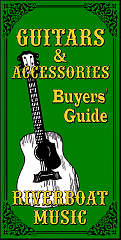
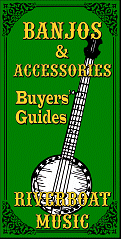
| Please Read: How to Help Our Site at No Cost to You - Some of our articles contain recommendations for products we like and vendors we personally trust. Some of those vendors may pay us a very small commission if you click on a link and buy their products. This costs you nothing at all and helps offset the costs of what we do. So if we point you to something you decide to buy later, please make certain you come back through our site and click on the link directly. Thanks. |
| This Site is a Cookie-Free Zone - Except for discussion forums that you have to expressly register for, none of our pages use cookies of any kind. Some of the vendors we link to do, but that won't affect you unless you click on a link to their pages. Your continued use of this page indicates that you agree to our policy. For details, click here. |
Editor's Note: This article was written chiefly to
However, a few weeks after I wrote this article, I realized that people were finding it by googling "minstrel banjo." So I have added a separate article, much of which overlaps this article called Minstrel Banjos.
That article also contains content related to banjos that minstrels might have used as the minstrel movement waned after the Civil war, and explains why the term "minstrel banjo" almost always refers to banjos built before 1865.
So if your chief interest is in minstrel banjos, period, and not in Civil-War era banjos, you might just want to jump to the Minstrel Banjos article.
If, on the other hand, you're wondering how an eBay "Civil War" banjo that is clearly dated 1894 could possibly be authentic, or what kind of banjo it would be appropriate to take to a Civil War reenactment, stay on this page.
The photo below is a Boucher, which was one of the most popular banjo manufacturers before the Civil War. This is also a popular subject of reproductions for people who want to do mid-19th-century reenactments, so you'll see quite a few reproductions online, some listed as the original thing. (In fact, one expert tells me this is a reproduction. That's okay; the first Civil War soldier you see in the photos below is holding a Boucher that is NOT a reproduction.")
Civil War Banjos
Written by Paul Race for Creek Don't RiseTM
Civil War Banjos
As mentioned in my article on The Evolution of the Banjo, the earliest banjos in North America were based on African gourd instruments, but received updates like drum-shaped bodies and fingerboards about the same time they came to the attention of white musicians. As a rule these early banjos had necks that were pretty much cut out of slabs, with the tuning head part of the same slab. Though there may be some D-shape to the neck, you can tell it wasn't turned in a lathe, because the bump-out for the fifth string tuner is jig-sawed right into the neck.
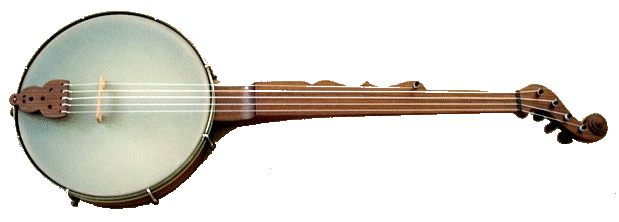
Features of this banjo and many of its contemporaries include scalloping under the fifth string, a scoop near the body for strumming, and a sideways scroll. Many of the cheaper banjos neglect these features, but if you have the chance to examine them, you'll see that they are also lacking frets, have fewer than 12 brackets, and the tuning head is a straight extension of the fretboard.

Brackets Vs. Tacks - The banjos above both have brackets for tightening the skin head. Just a few, though. By 1900, factory-built banjos had many more brackets - a safety feature that helped protect the head from uneven stresses.
Some of the earlier banjos had the skin head tacked on. If it got "sloppy" due, say, to high humidity, you would hold it over a candle briefly to dry the skin out and tighten it up again. Yes, this was a delicate operation.
Banjos On the Front
By the Civil War, minstrel shows and amateur banjo fans had helped spread the banjo across most of the country. And those banjos went to war. According to Bob Flesher, aka Dr. Horsehair, nearly every regiment, North and South had at least one banjo player and at least one fiddle player. So it's not anachronistic in Civil War-era movies or reenactments to bring a banjo and play it, especially if you play it with a style that is mostly strums (including what modern players call "frailing" and "clawhammer).
One example that's very authentic is an old Turner miniseries called Andersonville. The entire show used to be on YouTube, but Warner Brothers took it down. That said, a version with Spanish subtitles remains, and I took just the clip with the banjo part. In the clip, you'll see and hear a gut-strung, skin-head banjo playing authentic Civil-War-era style, thanks again to Bob Flesher, who built the banjo and trained the actor who plays it. One shot from the program is below. I apologize for the low resolution, but you get the general idea.
If the YouTube link below doesn't work, click here
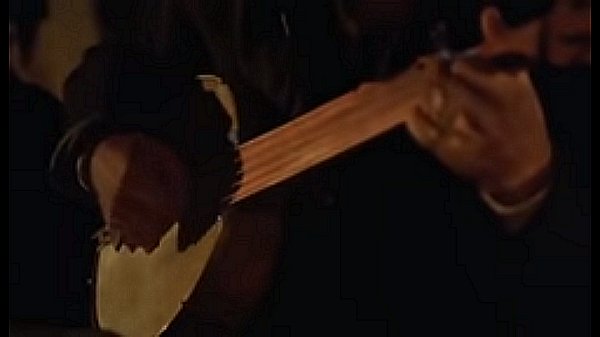
I'm thinking that Jack White's banjo parts in Cold Mountain are very similar.
Minstrel Banjo Rims
In addition to the obvious visual differences between pre-and post-Civil War banjos, Terry Bell, who has a reputation for making very authentic minstrel banjos, informs me that the minstrel banjo rim is thinner than later banjos. According to Terry:-
I bend my own rims of red oak which is what William Boucher did, and the famous Sweeney banjo used his design. . . . [Also] The adjuster nuts are at the bottom of the rim. This is important because this does not interrupt the vibration within the rim. Minstrel rims, with their thin rims absorb the vibration, versus modern banjos with thick rims which reflect the vibration.
Apparently the end result is a richer low midrange that you don't get with thick rims or shoes bolted to the side of the rim.
Visually, no one will notice the difference, and no one but banjo players will really hear the difference unless they have a chance to A/B two similar instruments side by side. But Terry's fans say there is a difference.
Banjos in Old Photos
Often when discussions about Civil War era banjo emerge, certain photos are used. I didn't post these at the top of the article, because the nature of early photography has led to many strange conversations. During the Civil War, portrait photos were mirror images. So when a banjo player or guitar player was going to be photographed, he often held his banjo "backwards," so that in the photograph, it would look like he was holding it "right." Of course, eagle-eyed pickers always notice that the fifth string is on the "wrong side." Sometimes the photos get flopped, which makes the banjo look right, but makes it look like the subject is holding the banjo "backwards."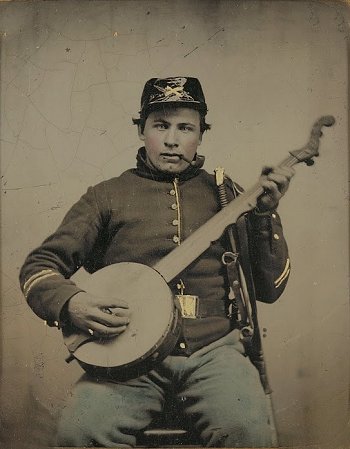 |
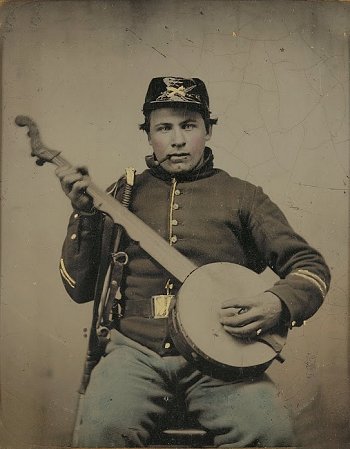 |
If you don't believe me, look at the buttons on his jacket. Civil War uniforms that had a single row of buttons button just like modern shirts, with the buttonholes on the left. |
The fellow below usually shows up only in the "flopped" version. Again, look at the buttons. The picture that looks like he's holding a left-handed banjo is the original mirror image that he gave to his family before he went off to war. (His family didn't care if his banjo looked backwards.) The photo that looks like he's holding a right-handed banjo backwards has been flopped.
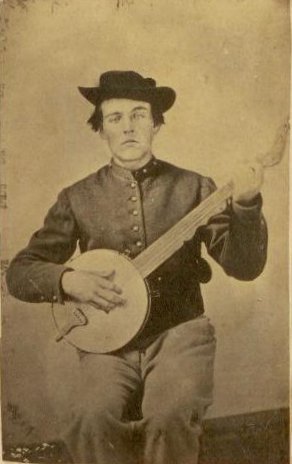 |
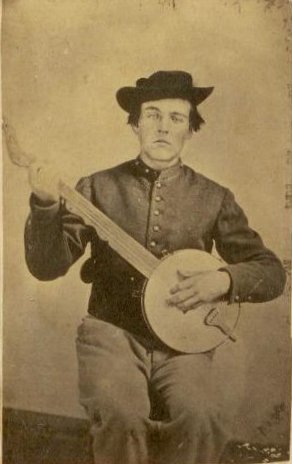 |
 By the way, most of the Civil War era photos I could find of people holding banjos featured "minstrel"-style banjos with the sideways scroll. The fellow to the right seems to be holding a home-made banjo, but the peg-head is shaped a little more like modern banjos.
By the way, most of the Civil War era photos I could find of people holding banjos featured "minstrel"-style banjos with the sideways scroll. The fellow to the right seems to be holding a home-made banjo, but the peg-head is shaped a little more like modern banjos.
A friend has shown me 1860s banjo photos with similar peg heads and round pots that don't look too different from modern banjos, so I may have misjudged some banjos that were advertised as "Civil War" era as looking too modern. If only so many of them didn't say "1889" o the tailpiece.
Why did I go to so much trouble to explain why these old photos seem to feature either left-handed banjos or subjects who don't know how to hold a banjo? Because such photos confuse people who don't understand the nature of 1860s photography.
And, believe it or not, when I've written similar articles using similar historical photos, I've gotten angry mail from readers who think I'm making this up. Look at the buttons, folks - I have yet to see a photo that was actually showing a left-handed minstrel or other pre-1865 banjo.
Banjos in Reenactments
Now to address my dissatisfaction with "Civil War reenactors" who bring banjos with "improvements" that were not made until 1870 or later.Folks whose costumes and hair styles are perfect, sometimes in recreations where the people in charge count buttons and do all sorts of things to make the recreation as accurate as possible.
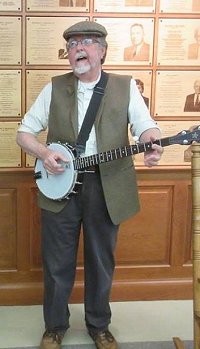 Historical reenactments are fun - I have been doing something like historical recreations for about 5 years, playing banjo in clothing that would pass for that of an early 1900's Irish immigrant.
Historical reenactments are fun - I have been doing something like historical recreations for about 5 years, playing banjo in clothing that would pass for that of an early 1900's Irish immigrant.
I have to confess that my costume, such as it is, wouldn't stand a very close inspection - it's mostly modern-day clothing that has been recut to resemble earlier styles.
However, I am VERY careful about using banjos that are appropriate for the era. My backless, dark-toned 5-string Deering Classic is actually a pretty good stand-in for many instruments of the early 1900s. Nowadays, Deering has replaced the "Classic" with the "Artisan," which looks even more authentic.
But I would never dream of taking either instrument to a period previous to 1870, when commercial banjos not so different from mine first started becoming widely available.
Here are some features that generally were added after the Civil War, though some were added prior to 1880
- Frets
- True D-shaped neck
- Peg head leaning back from the angle of the neck
- More than 12 brackets
Now, I won't swear that these NEVER appear on a Civil War era banjo, but I have yet to have an authentic Civil War banjo in my hands that had any of these features. I have seen any number of alleged "Civil War-era" banjos for sale online that have them all. More on that below.
After 1870, innovation was rampant, and many manufacturers strove hard to keep up with the competition's improvements. The number of brackets shot up to as many as thirty. Metal strings began to be added, which required geared tuning pegs, sometimes in slotted heads. Though metal wraps around the wooden pot were introduced in 1855, they don't seem to have really caught on until after the war (their use faded in the early 1900s). Resonators, resonator flanges, and tone rings came even later.
Back to Civil War era banjos - they have a uniqe look and sound that is unforgettable. Yet I see many photos of "Civil War reenactors" playing resonator- and flange-equipped banjos that couldn't possibly have been built before 1920. And I've seen a few photos of folks in authentic Civil War clothing playing banjos that obviously date to the 1980s or later.
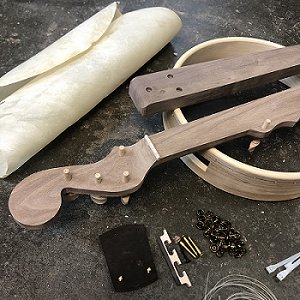
The truth is, even the most conscientious reenactment organization doesn't have experts on everything, so these anachronisms get through.
If you really want to look authentic and you can't afford a $1200 recreation or $5000 original, consider buying something like the Carver Minstrel banjo kit shown at right.
Civil War Playing Styles
Early banjo players, even white ones, used a strumming style similar to the style used by Akonting players back in Africa. When the fretboard was added, it became easier to play melodies and more complicated parts. However the basic playing motion still consisted of flicking or strumming with the back of the right hand fingernails and picking the drone string with the thumb.If you have learned a frailing or clawhammer pattern that works for you, you're probably pretty close.
Scruggs-style three-finger picking didn't come along until 8 or 9 decades after the Civil War. Yet I've seen a video of a person who was supposedly celebrating the banjo's role in the Civil War give a stirring performance playing Scruggs-style on a modern banjo. I don't even know what to say.
No picks, more strumming that picking are what is called for. If you want to play melody, play it in between the downward strums with the back of the fingernail on your first or second finger. According to Bob Flesher, "Bluegrass Pickers Can Learn Clawhammer."
Mislabeling and Misrepresenting
I recently got dragged into an "uncomfortable discussion" about why a factory-built banjo with improvements that generally didn't appear until about 1880 probably wasn't a "Civil War era" banjo.
As I understand it, the reader had received a vintage banjo of uncertain provenance and taken it to the "banjo expert" in a regional music store. The expert went online and saw a half-dozen similar banjos for sale. They were all (mis-)labeled as "Civil War era." So, my reader's banjo must also have been a "Civil War era" banjo, despite the fact that the tailpiece was stamped "Patent 1897."
Now it's no "skin off my nose," as they say, if a reader is telling friends who come over to the house that his banjo was played at Bull Run or some such. But I did want to help my other readers tell the difference.
First of all, very few auction houses or eBay sellers are remotely qualified to determine what is and isn't a "Civil War era" banjo. A quick search for "Civil War banjo for sale" on the internet today brought up:
- One banjo that is almost certainly Civil War era, with a price that reflects it.
- One banjo with frets, 28 brackets and a tailpiece that said "Patent April 5, 1887."
- A banjo with frets, metal wrap around the pot, and a kind of eagle-shaped bracket "shoes" that I've never seen dated earlier than 1870.
- A banjo with a slab minstrel-style neck (good), metal wrapped around the pot (suspicious) and enough replacement parts to keep it from being a real collector's item, though it would pass for authentic in most circumstances.
- Several reproductions being advertised as such.
- Several reproductions being advertised as originals.
- Several obviously post-1900 models advertised as "Civil War era." This included some 4-strings, which did not become popular until about 1910.
Conclusion
When I published the first draft of this article, I sent it to four folks who know a lot more about minstrel and Civil-War era banjos than I do, and two of them have responded to say that I have my facts straight as far as they know.That said, my list of things that might disqualify your banjo from being a Civil-War era banjo is not "cast in stone." The banjo has always been subject to experimentation, after all, and there might be pre-1865 instruments that were well ahead of their time. If you have one, please let me know. Send me photos and evidence that it was built before 1886. I will GLADLY update this article (trust me, I've updated hundreds of others). Reader feedback is the reason I started this project in the first place. And I wouldn't be surprised if I find myself going back to change details as old, but buried facts come to light.
On the other hand, I've already received my share of comments like "Great-Uncle Fezziwig always told me such-and-such, so you're wrong." As much as I may admire your Great-Uncle Fezziwig personally, back when I was editing history books for a living, I used to fact-check my fact-checkers, so I have an unpopular habit of distinguishing "common knowledge," family folk-tales, and unsupported assertions from facts.
Update, 2024
So, on a popular banjo forum, I recently answered a question from a fellow trying to find a banjo for a Civil War reenactment. I also shared this link, which brought folks who are interested in 19th-century music "out of the woodwork" with suggestions and - frankly - criticisms. In retrospect, I'm sure they were trying to be helpful.
Ironically, in multiple cases, they told me I needed to familiarize myself with better sources - and pointed me to the same sources I used when I put this article together.
I have made three minor corrections, and I will check out some of the other resources they mentioned and tweak accordingly if necessary.
That said, if you come across resources similar to this one that have information I haven't included, please let me know.
Stay in Touch
I still like helping newbies, as well as getting questions and interacting with fellow musicians of all stripes. So please stay in touch. Consider following my CreekDontRiseTM Facebook page.. DM me there if you have any questions or comments.
Other Articles about the Banjo
- Minstrel Banjos - a "sister article" to this one that leaves out most of the Civil War-era content and adds minstrel-specific content.
- What Kind of Banjo Do I Want?
- The Evolution of the Banjo
- Whatever Happened to the Banjo?
- 6-String Banjos
- Banjo Pickups
- What is a Bluegrass Banjo?
- What is a Tenor Guitar?
- Dean "Backwoods Six" Shootout
- What is a Zither Banjo?
- Five String Banjo Tabs and Instructions
 Whatever else you get out of our pages, I hope you come away with some great ideas for "sharing the joy."
Whatever else you get out of our pages, I hope you come away with some great ideas for "sharing the joy."
And please stay in touch!
All material, illustrations, and content of this web site is copyrighted (c) 2001, 2002, 2003, 2004, 2005, 2006,
2007, 2008, 2009, 2010, 2011, 2012, 2013, 2014, 2015, 2016, 2017, 2018, 2019, 2020, 2021, 2022, 2023, 2024 by Paul D. Race. All rights reserved.
Creek Dont' Rise(tm) is a participant in the Amazon Services LLC Associates Program, an affiliate advertising
program designed to provide a means for sites to earn advertising fees by advertising and linking to Amazon.com.
For questions, comments, suggestions, trouble reports, etc. about this page or this site, please contact us.
| Visit related pages and affiliated sites: | |||||
| - Music - | |||||

|
 |
 |

|

|

|

|

|

|

|

|

|

|

|

|

|

|

|
| - Trains and Hobbies - | |||||
 |

|

|  |
 |

|
| - Christmas Memories and Collectibles - | |||||
 |

|
 |

|
 |

|
| - Family Activities and Crafts - | |||||
 |

|

|

|

|

|

